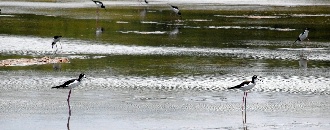DLNR, WILDLIFE PARTNERS TO SURVEY WATERBIRDS STATEWIDE
Dozens of wildlife biologists will visit Hawai’i’s wetlands on Wednesday, August 19, 2009 for the statewide bi-annual waterbird survey.
Department of Land and Natural Resources’ (DLNR) Division of Forestry and Wildlife staff and volunteers will survey more than 250 wetland sites where waterbirds are known to gather — including marshes, reservoirs, golf course canals, prawn farms, sewage treatment plants and even the Honolulu International Airport’s reef runway.
The statewide bi-annual waterbird surveys are organized by DLNR’s Division of Forestry and Wildlife (DOFAW), with cooperation of the U.S. Fish and Wildlife Service, the National Parks Service, The Nature Conservancy of Hawai’i, the Hawai’i Audubon Society, and other partner organizations.
O’ahu sites that will be surveyed include the Hamakua Marsh, Kawainui Marsh, He’eia Wetlands, Pouhala Marsh, Ke’ehi Lagoon, and the North Shore taro lo’i and lotus fields where endangered gallinules, coots and stilts are found.
“We’ve been conducting waterbird surveys for over 30 years,” DLNR Chairperson Laura H. Thielen said. Â “The information gathered gives us important trend data for our endangered waterbirds, migrant waterfowl, and shorebirds.”
“Counting birds gives us important insight on the status of different species statewide, and helps us to better manage our endangered waterbird populations,” she added.
“Trend data for the Hawaiian Stilt indicates that statewide Hawaiian Stilt counts are at some of the highest levels seen in over 10 years,” Paul Conry, DLNR Division of Forestry and Wildlife administrator, added.. Â “On the island of O’ahu, the number of Hawaiian Stilts has gone from 553 counted in 1997 to over 860 Stilts counted in 2007.”
The last survey in January 2009 of state wildlife sanctuaries on Oahu at Pouhala, Kawainui, Hamakua, and Paiko Lagoon showed increases in both range and numbers of birds as more habitat is restored each year.
“For our wildlife managers on O’ahu this is an important sign that the measures they’ve been taking to improve Stilt habitat and control predators at known nesting and foraging sites are having a positive impact on the species,” Conry said.
The data collected during waterbird surveys are used by DOFAW, the U.S. Fish and Wildlife Service and other partner organizations to determine population trends and habitat use of the four endangered waterbird species in Hawai’i – the Hawaiian stilt (Himantopus mexicanus knudseni), Hawaiian moorhen (Gallinula chloropus sandvicensis), Hawaiian coot, (Fulica alai), and Hawaiian duck (Anas wyvilliana).
In addition to these priority species, all bird species present at a survey area are recorded, as well as weather and survey area conditions.
After counting the birds and taking field notes report sheets are faxed or mailed to the Hawai’i Biodiversity and Mapping Program at the University of Hawai’i at Manoa. Â Trained staff then enter, proof, inventory and document the waterbird data. Â A Microsoft Access database allows for streamlined data entry, minimized data entry errors, and the generation of automated summary figures and reports.
Local coordinators for the survey operations are DOFAW wildlife biologists. Â They are: Â on O’ahu, Jason Misaki, 973-9786; Kaua’i, Thomas Kaiakapu, 274-3440; Maui, Fern Duvall, 873-3502; Big Island, Joey Mello 974-4229.
Members of the public who are interested in assisting DLNR with the surveys may contact the district biologists in advance to sign up to participate.
(Posted by Wendy Osher, Information provided by the State Department of Land and natural Resources, Division of Forestry and Wildlife)











